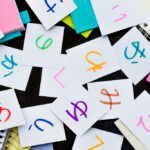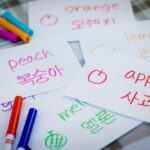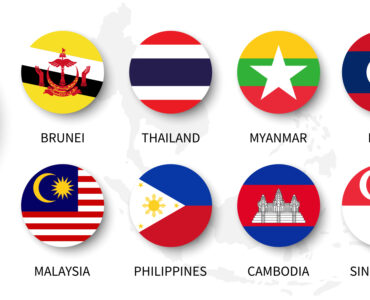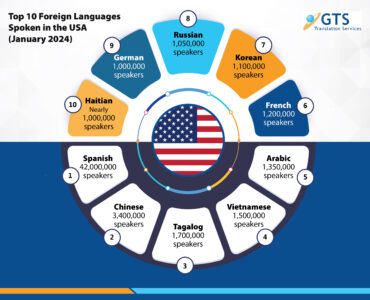by William Wilde
From an English speaker’s perspective, when learning a new language, it’s interesting to look at the relative difficulties. Chinese, Japanese, and Korean are all significantly more complex than, say, French or Spanish. Yet, there are some surprising aspects of each language that are easier than you’d think. Read on for the lowdown on the unique challenges and joys of each of them.
Chinese: Easy Grammar and Tough Pronunciation

Relatively speaking (and ‘relative’ is a common theme here, as learning any language is a long-term project with certain difficulties), Chinese has a grammar system that’s easy to grasp.
Note that there are two main forms of Chinese: Mandarin and Cantonese. Mandarin is more widely spoken and has fewer tones than Cantonese (more on those below). The fact that Mandarin has more speakers means there are more resources for learning it (for the same reason German and Italian have more resources than Romanian or Czech). So, it’s often said Mandarin is the easier form to learn.
In comparison to Japanese and Korean, the Chinese grammar system is simpler because its word order is structurally more similar to English. It uses subject, then verb, then object, such as, “I eat apples,” rather than Japanese’s or Korean’s subject-object-verb order, “I apples eat.”
Chinese also doesn’t have verb conjugations (remember those lists of Spanish verb tenses in high school? You can forget about that in Chinese).
Rather, saying something happened in the past, is happening now, or will happen in the future is implied by words such as ‘yesterday’, ‘today’, and ‘tomorrow’. In other cases, you often stick a small particle word in the sentence to indicate this. This is much easier than remembering exactly which verb ending to use.
However, Chinese and Japanese almost have opposite problems in that Chinese has much easier grammar but is far harder to pronounce properly.
This is because of the tone system in Chinese. The same sound, such as ‘ma’, can be pronounced in four different ways and mean completely different things. For example, two meanings of this sound are ‘mother’ and ‘horse’, so you can imagine the confusion if you get it wrong.
On top of that, Chinese arguably has the most difficult writing system, called hanzi. As a bare minimum, you’ll need to know 3,500 separate hanzi characters to be literate and 5,000 to understand the majority of words you’ll come across. Compare that to 2,000 as a base level for Japanese, and you’ll see it’s a lot more learning.
On the other hand, one thing that makes individual hanzi characters easier to learn is that each character generally has one ‘reading’ or sound associated with it. Kanji, the Japanese writing system, can have multiple ways of pronouncing the same symbol, so each is certainly challenging.
Japanese: Tricky Grammar, Three Writing Systems, but a Cinch to Pronounce

As mentioned, Japanese is almost the opposite of Chinese as far as challenges are concerned: The grammar is complex, but pronouncing it is quite easy.
That’s because Japanese uses a short range of syllables without tones. So, once you get to grips with how these syllables work together, pronouncing words feels a little like slotting Lego blocks together. It’s quite hard to get wrong, and small mispronunciations are usually still understandable.
This is in stark contrast to Chinese, where a mispronounced word completely changes its meaning to the point of being incomprehensible. You should always make an effort to pronounce words properly, but the little mistakes you make early on in Japanese won’t hinder you nearly as much.
However, one of the most difficult aspects of Japanese is its grammar. It relies heavily on small particle words to add meaning to sentences. Also, the aforementioned subject-object-verb structure is very different to the way English sentences are constructed.
Japanese requires more study of verb constructions, and using the wrong suffix can mean placing it in the wrong time (today versus yesterday, for example) and turning your sentence into nonsense.
Another unique aspect of Japanese is that it uses three writing systems. Technically, they’re not alphabets like the Latin one we use. Rather, Japanese uses pictograms (kanji, derived from hanzi) and two syllabaries (characters that represent whole syllables, such as na, ni, no, etc.)
The two syllabaries, hiragana and katakana, consist of 46 characters each, so each has more than our alphabet, but not an overwhelming number. Indeed, if you put your head down for a few days, you could learn both of them.
Kanji shares many similarities with Chinese hanzi to the extent that learning one makes learning the other far easier. Yet, it has its unique quirks, such as the previously-mentioned multiple sounds. In any case, it will take several years of consistent study to learn it to the point of literacy.
Korean: Difficult Grammar but Delightfully Simple Writing

The great thing about Korean is that, compared to Chinese and Japanese, the writing system (hangul) is a relative cakewalk.
That’s because, rather than having a symbol to represent each individual word, Korean uses an alphabet (like we do in English), and it only has 24 letters. Compared to the countless hours of back-breaking effort you’ll need to read and write Chinese or Japanese, you can learn hangul in a matter of hours.
It’s certainly very different to the Latin alphabet, as it has 10 vowels, compared to the 5 in ours. So, it might take a little time to train your brain to think in hangul, but it’s undoubtedly easier than hanzi or kanji.
Something that’s also deceptively simply about hangul is the lack of capital letters. Consider how different some capital and lowercase letters look in our alphabet (D and d, or G and g, for example), and you realize the Latin alphabet is almost twice as complex as it looks. There’s none of that in Korean; it’s just the 24 letters as they are.
This means that you’ll be able to start reading out loud in Korean very quickly (even if you don’t know the meanings of all the words yet). Used as a study tool, your reading practice will help you with other aspects of Korean early on, such as vocabulary.
In terms of grammar, it’s often said that Korean grammar is the toughest of the three when compared to Chinese and Japanese. Korean is what’s known as ‘agglutinative’, meaning words are often stuck together to create new meanings. This can make individual words, when first looked at, trickier to figure out.
It also uses a lot of connectors to form sentences, and this can take quite a lot of practice to start using naturally.
As far as pronunciation goes, Korean is intermediate between Chinese and Japanese: It doesn’t use tones, but the sounds are a little harder to grasp than the relatively simple ones in Japanese.
In summary, there’s certainly no easy road to learning Chinese, Japanese, or Korean. Each language is complex for unique reasons, and you’ll need perseverance to overcome these challenges. However, if you have a passion for Chinese, Japanese, or Korean, that in itself will help a lot with success. When you love learning a language, exploring its country’s culture, and absorbing its media, you’ll find it much easier to master!
About the Author

William is a professional writer living in the south of the UK whose interests include web content writing and foreign languages. He has a wide range of interests and writes mainly in the fields of personal finance, psychology and history.





